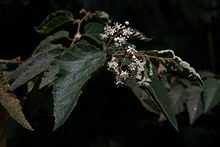Commersonia fraseri
| Brush Kurrajong | |
|---|---|
| | |
| Commersonia fraseri, Telegherry River, near Dungog, Australia | |
| Scientific classification | |
| Kingdom: | Plantae |
| (unranked): | Angiosperms |
| (unranked): | Eudicots |
| (unranked): | Rosids |
| Order: | Malvales |
| Family: | Malvaceae |
| Genus: | Commersonia |
| Species: | C. fraseri |
| Binomial name | |
| Commersonia fraseri J.Gay | |
Commersonia fraseri, commonly known as Blackfellow's Hemp or Brush Kurrajong is a common shrub or small tree of the mallow family found in eastern Australia.[1] Growing up to 8 metres tall, it is found in rainforest margins and in wet eucalyptus forests.
Taxonomy
The French naturalist Jacques Etienne Gay was the first to name the species, in 1823.[2] The genus is named after the French naturalist Philibert Commerson, and the species name honours the colonial botanist of New South Wales Charles Fraser.[3] Vernacular names include brush kurrajong and blackfellows hemp.[2]
A 2011 molecular analysis of segments of chloroplast DNA found that the genera Commersonia and Rulingia formed a monophyletic group but that the member species were intermingled, and split out into two hitherto unrecognised clades.[4] C. fraseri belongs to a clade which has been reclassified as a new genus Androcalva, and hence its new binomial name is Androcalva fraseri.[5]
Description
Commersonia fraseri grows as a 2 or 3 m (7–10 ft) shrub,[6] or small tree to 8 m (25 ft) high. Arranged alternately along the stems,[3] the ovate leaves have irregularly toothed margins and are 5–17 cm (2–6.5 in) long and 2–7 cm (0.8–2.4 in) wide. The leaf undersides are whitish, and covered in a fine fur.[1] Flowering peaks in September and continues till November.[7] The small white flowers are arranged in clusters. Flowering is followed by the development of fruit, 1.5 to 2.5 cm (0.6–1 in) long.[6]
Distribution and habitat

Commersonia fraseri is found in rainforest and wet eucalypt forest along and east of the Great Dividing Range in New South Wales[1] and southeastern Queensland.[3] In the latter habitat, it is associated with trees such as rough-barked apple (Angophora floribunda), turpentine (Syncarpia glomulifera), and Sydney blue gum (Eucalyptus saligna).[7] A fast-growing plant, it is able to colonise disturbed ground,[7] particularly areas where vegetation has been partly cleared such as under power lines.[6]
It is an adult host plant for the chrysomelid beetle Podagra submetallica.[8]
Cultivation
Commersonia fraseri has been propagated readily from cuttings taken in winter, and grows better with extra moisture in cultivation.[3]
References
- ↑ 1.0 1.1 1.2 "Commersonia fraseri". PlantNET – NSW Flora Online. Retrieved 2010-11-16.
- ↑ 2.0 2.1 "Commersonia fraseri J.Gay". Australian Plant Name Index (APNI), IBIS database. Centre for Plant Biodiversity Research, Australian Government.
- ↑ 3.0 3.1 3.2 3.3 Lodder, Mark (16 December 2003). "Growing Native Plants: Commersonia fraseri". Canberra, Australian Capital Territory: Australian National Botanic Gardens, Australian Government. Retrieved 8 December 2011.
- ↑ Whitlock, Barbara A.; Hale, Amanda M.; Indorf, Jane L.; Wilkins, Carolyn F. (2011). "Polyphyly of Rulingia and Commersonia (Lasiopetaleae, Malvaceae s.l.)". Australian Systematic Botany 24 (5): 215–25. doi:10.1071/SB09030.
- ↑ Wilkins, Carolyn F.; Whitlock, Barbara A. (2011). "A new Australian genus, Androcalva, separated from Commersonia (Malvaceae s.l. or Byttneriaceae)". Australian Systematic Botany 24 (5): 284–349. doi:10.1071/SB10032.
- ↑ 6.0 6.1 6.2 Fairley, Alan; Moore, Philip (2000). Native Plants of the Sydney District:An Identification Guide (2nd ed.). Kenthurst, New South Wales: Kangaroo Press. p. 80. ISBN 0-7318-1031-7.
- ↑ 7.0 7.1 7.2 Benson, Doug; McDougall, Lyn (2001). "Ecology of Sydney plant species Part 8: Dicotyledon families Rutaceaae to Zygophyllaceae". Cunninghamia 7 (2): 241–462.
- ↑ Hawkeswood, Trevor J. (2005). "Three new host plants for the Australian leaf beetle Podagrica submetallica (Blackburn, 1894) (Coleoptera: Chrysomelidae: Alticinae)". Calodema 4: 19–22.
External links
 Media related to Commersonia fraseri at Wikimedia Commons
Media related to Commersonia fraseri at Wikimedia Commons